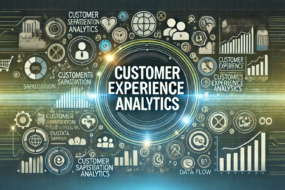
Imagine walking into a store, browsing some products, and then getting a friendly email a few days later with a special offer for that exact item you were eyeing. Or maybe you start shopping on a brand’s website, add a few things to your cart, and then get a reminder on your phone later to complete your purchase, all without skipping a beat. This is the magic of omnichannel analytics in action, where businesses seamlessly connect with customers across multiple channels to create a consistent and personalised experience.
In today’s fast-paced digital world, customers don’t interact with brands through just one channel. They might start their journey on social media, continue on a website, ask questions via a chatbot, and complete a purchase in-store or through a mobile app. Omnichannel analytics helps businesses track these interactions across all touchpoints to understand the complete customer journey. So, let’s dive deeper into what omnichannel analytics is, why it’s essential, and how it can transform your customer experience.
What is Omnichannel Analytics?

Let’s start with the basics. Omnichannel analytics is all about understanding how your customers interact with your brand across multiple channels—whether that’s online, in-store, through social media, on mobile apps, or even via customer service. It’s like piecing together a puzzle where each channel is a different piece, and the full picture is your customer’s entire journey.
Think of it this way: Your customers don’t see your brand as separate entities—your website, your physical store, your social media pages—they see it as one brand. They expect a seamless experience no matter where or how they interact with you. Omnichannel analytics helps you understand these interactions in a unified way, so you can provide that seamless experience.
Why is Omnichannel Analytics Important?

You might be wondering, “Why should I invest time and resources into omnichannel analytics?” Here’s why:
- Understand the Complete Customer Journey: Customers today don’t stick to just one channel. They might discover your brand on Instagram, browse products on your website, and then visit your store to make a purchase. Omnichannel analytics helps you track these journeys from start to finish, giving you a complete picture of your customers’ behaviour.
- Provide a Seamless Experience: Imagine a customer who starts shopping on your app but finishes the purchase on your website. If you’re not tracking this journey, you might lose out on crucial insights, leading to a disjointed experience. Omnichannel analytics ensures that no matter where your customer interacts with you, the experience feels connected and personalised.
- Boost Customer Loyalty: When customers feel that you understand their needs and provide a consistent experience across all channels, they’re more likely to become repeat customers. Loyalty is built on trust, and omnichannel analytics helps you build that trust by ensuring every interaction is smooth and personalised.
- Optimise Marketing Strategies: With insights from omnichannel marketing analytics, you can see which channels are driving the most engagement and conversions. This allows you to focus your marketing efforts where they’ll have the most impact, ultimately improving your ROI.
How Does Omnichannel Analytics Work?

To get a clearer picture, let’s break down the components of omnichannel analytics and explore how they work together to provide a holistic view of the customer experience.
Identify Your Channels
The first step in omnichannel analytics is to identify all the channels where your customers interact with your brand. These could include:
- Digital Channels: Your website, mobile app, social media platforms, email marketing, and online ads.
- Physical Channels: Brick-and-mortar stores, events, kiosks, and customer service centres.
- Hybrid Channels: Click-and-collect services, QR codes that bridge online and offline experiences, and integrated loyalty programs.
Integrate Your Data
Integrating data from multiple channels can be challenging, but it’s essential for omnichannel analytics to work effectively. This involves:
- Data Unification: Bringing together data from different sources into a single view. This could mean integrating your website analytics with your in-store purchase data or combining social media interactions with email marketing responses.
- Real-Time Analytics: To provide a seamless experience, it’s crucial to analyse data in real-time. If a customer adds a product to their cart on your website, your app and customer service team should have that information immediately.
- Data Cleansing and Quality Control: Ensuring that the data you collect is accurate, up-to-date, and free of duplicates or errors. Clean data is the foundation of any successful omnichannel analytics strategy.
Analyse Cross-Channel Behaviour
Once you have your data integrated, the next step is to analyse it for actionable insights. Here are some key areas to focus on:
- Customer Behaviour: Understand how customers interact with different channels. Are they using your mobile app to browse but making purchases on the website? Are they coming to the store after receiving an email promotion?
- Channel Performance: Evaluate how each channel performs individually and in conjunction with others. Which channels drive the most engagement? Which ones are most effective at converting browsers into buyers?
- Customer Sentiment and Feedback: Monitor customer feedback across channels. Are there consistent complaints or praises about a particular touchpoint? Use this information to improve your overall experience.
Optimise and Personalise
Data is only as valuable as the actions it drives. Here’s how you can turn your omnichannel data analytics into tangible improvements:
- Optimise Customer Support: If you notice that customers frequently use live chat for certain types of queries, ensure your team is well-equipped to handle those issues promptly. Alternatively, use AI-driven chatbots to provide instant support and route more complex queries to human agents.
- Personalised Marketing: Use insights to create highly targeted marketing campaigns. If a customer frequently shops in-store but rarely visits your website, consider offering online-exclusive discounts to encourage cross-channel engagement.
- Enhance Inventory Management: If data shows that certain products are popular online but have low in-store sales, consider adjusting your inventory levels or offering special promotions to drive in-store traffic.
Monitor and Adjust
Omnichannel analytics is not a one-time effort but an ongoing process. Continuously monitoring your data allows you to identify new trends, spot potential issues, and adjust your strategies accordingly. Here’s how to stay agile:
- Track Emerging Trends: Customer behaviour evolves, and so should your approach. Regularly review how customers are interacting with your channels. Are new channels becoming more popular? Is there a shift in how customers prefer to engage with your brand?
- Test and Learn: Implement A/B testing to experiment with different strategies, such as altering marketing messages, promotions, or customer service approaches. Analyse the results to determine what works best across various channels.
- Iterate on Personalization: Continuously refine your personalization efforts based on customer preferences. If data reveals changing customer preferences or buying patterns, adjust your offerings and marketing campaigns to keep them relevant.
What Are the Key Questions in Omnichannel Analytics?

To make the most of omnichannel analytics, you need to ask the right questions. Here are some key questions to consider:
1. How Are Customers Moving Between Channels?
Do you know how your customers are navigating from one channel to another? Are they discovering your brand on social media before visiting your website, or are they coming directly to your store after an email campaign? Understanding these patterns helps you identify which channels are most effective at different stages of the customer journey.
2. Where Are the Gaps in the Customer Experience?
Are there any points in the customer journey where the experience feels disjointed? Maybe customers are dropping off when switching from your mobile app to your website, or they’re frustrated by the lack of integration between online and in-store experiences. Identifying these gaps allows you to smooth out the rough edges and provide a more cohesive experience.
3. What Channels Drive the Most Value?
Which channels are generating the most sales, engagement, or customer satisfaction? Is your social media presence driving more traffic than your email campaigns? Are customers who engage with your brand across multiple channels more likely to make a purchase? Understanding the value of each channel helps you allocate resources more effectively.
4. How Can You Personalise the Experience Across Channels?
Personalization is key to a great customer experience. But how do you ensure that personalization is consistent across all channels? For example, if a customer has shown interest in a particular product on your website, how can you use that information to tailor the content they see in your next email or in-store visit? Omnichannel analytics solutions helps you deliver personalised experiences at every touchpoint.
What Tools Can Help You with Omnichannel Analytics?
Now let’s talk about some tools that can help you get the job done:
Google Analytics 4 (GA4)
GA4 is designed to track user journeys across different platforms and devices. It gives you a comprehensive view of how customers are interacting with your brand, whether they’re on your website, app, or even offline channels.
Salesforce Marketing Cloud
Salesforce Marketing Cloud is perfect for managing and analysing customer interactions across multiple channels. It helps you create personalised marketing campaigns based on data from every touchpoint, ensuring a consistent customer experience.
Zendesk
If customer service is a critical part of your business, Zendesk can help you track and manage interactions across various channels. Whether customers are reaching out via email, chat, phone, or social media, Zendesk helps you provide a seamless support experience.
HubSpot
HubSpot offers a suite of tools for managing customer relationships across multiple channels. It’s great for small to medium-sized businesses looking to integrate their marketing, sales, and customer service efforts in one platform.
Adobe Experience Cloud
Adobe’s suite of tools is designed to help you understand customer journeys across all channels. With powerful analytics and personalization features, it’s ideal for large enterprises looking to provide a highly tailored customer experience.
What Are the Challenges in Omnichannel Analytics and How to Overcome Them?
Like anything worth doing, omnichannel analytics comes with its own set of challenges. Here’s what you should be aware of:
- Data Silos: One of the biggest challenges is breaking down data silos. When data is isolated in different systems, it’s hard to get a full picture of the customer journey. Investing in tools that integrate data across channels is key to overcoming this challenge.
- Consistency Across Channels: Ensuring a consistent experience across all channels can be tough, especially if different teams manage different channels. Clear communication and alignment between teams are essential for a smooth omnichannel experience.
- Complexity in Data Integration: Pulling data from various platforms—such as mobile apps, websites, social media, and in-store systems—can be overwhelming. Each channel likely has its own format and data structure, making it challenging to unify everything into one coherent system. You’ll need advanced tools and platforms capable of integrating all these data points and presenting them in a meaningful way.
- Attribution Challenges: When customers interact with multiple channels before making a purchase, it can be hard to figure out which touchpoints had the biggest impact. Without a proper attribution model, it can be difficult to allocate marketing budgets efficiently and understand the true effectiveness of your campaigns.
- Real-Time Data Processing: In the world of omnichannel real time analytics, live insights can be invaluable. But collecting, analysing, and acting on data in real-time is not been an easy task. This requires advanced analytics tools capable of processing large amounts of data quickly.
Final Thoughts
Omnichannel analytics is the key to creating a truly seamless and personalised customer experience. By understanding your customers across all their touchpoints, you can meet them where they are and provide a consistent, engaging experience that drives loyalty and growth. Start by integrating your data, analysing it for insights, and taking action to optimise each channel. Your customers will thank you for it—and your bottom line will, too.








No Comments